MO Tested: Insta360 OneX Camera Review
Our first foray into 360 cameras
As you no doubt know, Motorcycle.com also produces videos to go along with nearly every motorcycle review we publish. So, when the opportunity came along to get our hands on a 360 camera for the first time, we couldn’t say no. Chances are you’ve already seen some footage with the camera in prior reviews, too. Normally, our video guy Sean Matic doesn’t involve himself with the written word, instead focusing his attention on moving pictures of the questionable MO team. But considering how he’s the one with the most “seat time” with the Insta360 OneX camera, we couldn’t think of anyone better to tell you how it works. Here are his impressions. -TS
Why 360-degree action cameras? One reason is for virtual reality or VR video. You know, that immersive video experience with special nerd goggles where technology fools you into feeling like you’re actually in a scene – like walking a tight rope 500 feet above the Grand Canyon – while standing in Best Buy. Cool stuff for sure, but not something we do here on the MO Tubes. So why 360 then? It’s a question I asked myself when I first heard 360 cameras were available and creating buzz at the consumer level. Truthfully, the VR world is not one I explored very much as the resident MOron with a camera. However, now that Insta360 sent us a OneX to test, I’m a convert.
What’s Inside
More than just a tool for making VR videos, a huge benefit of 360 cameras is the control you have in the post production editing workflow over what the audience views on the conventional 2-dimensional 16×9 screen. Essentially, the audience views whatever you want them to see in a 360-degree area around the camera. The beauty of this for action sports – where things come at you fast and unplanned – is that you can decide after the fact what you want to highlight and share with your audience.
Shop for the Insta360 OneX Camera here
Considering the OneX camera uses two lenses, each with a 200-degree field of view, and a Sony CMOS sensor, it’s a fairly streamlined and lightweight device, measuring 115mm x 48mm x 28mm and weighing just 115 grams with a battery installed. It’s not as compact as a GoPro or Sony action camera but, rather, shaped more like a small cell phone. It also doesn’t appear to be as robust should it get accidentally ejected off a mount and take a high speed tumble, though optional cases are available, including a rugged case for action sports and a water-tight case ideal for diving.
Never Miss A Moment
If you mount a traditional action camera on the front of your race bike and grab the holeshot, only to have some overzealous competitor ram it up your inside and bump you into the dirt, all you will see is an empty track in front of you as you miss the first turn and enter the dirt. Mount that same camera on the back of your BMW GS on your Alaskan adventure to catch your buddies eating your roost behind you, and you might miss capturing the 10-foot tall grizzly bear in the middle of the trail, stopped dead in your tracks. With a 360 camera you can capture all the action with one camera.
In the holeshot scenario, you can capture your competitors all around you as you fire down the start straight. When that kamikaze pilot makes his move, you can track his crappy life choice from start to finish and the viewer will get a feel for how much action was going on all around you. Our Alaskan adventure friend could have mounted a 360 camera on the nose of his bike and gotten a perspective of his own face and his mates behind him, then after his eyes got as big as saucers swing the POV around to reveal the grizzly bear in his path. Sure, you could put four action cameras on your bike to cover 360 degrees, but then you’d have to contend with the action coming in and out of the frame of each camera.
With the 360 camera you can move the POV to follow the action, keeping it centered in frame or let it move in or out of frame if you choose to do a reveal. Then there’s the ease of starting and stopping one camera and handling only one SD card. Additionally, 360 cameras are much more forgiving when it comes to getting the angle just right compared to a conventional action camera because you can always shift the viewer’s perspective a bit if you have the camera tilted too low, too high, or not level with the horizon.
Best of all, for us motorcyclists, is the Insta360’s internal stabilization, called Flowstate Stabilization, centered around a six-axis gyroscope not too dissimilar to the Inertial Measurement Units seen on many of today’s sportbikes. Since you’re reading this, you probably know how shaky videos from a motorcycle can be. I can write about how well Flowstate Stabilization works, but it’s a lot easier to just watch the video above and see for yourself. It’s really good, right?
Using It
My first proper test with the Insta360 OneX was mounting it on a special lightweight camera vest, the Glide Gear Medusa Body Harness, giving a POV as if you were looking over my shoulder. The resulting video was great once I watched a few tutorial videos on the Insta360 and realized I needed to download the Insta360 Studio desktop software (Windows and Mac compatible) in order to import media off the micro SD card and convert it to a format my editing software of choice (Final Cut Pro X) could recognize and handle. A word to the wise: for moto video applications it makes life a million times easier to check off lock direction in the Insta360 Studio software before you export, otherwise you will be constantly having to create key frames to keep the POV orientation constant (towards the front of the bike for instance) every time the bike changes orientation. Insta360 Studio also has Flowstate Stabilizationwhich combined with the stitching software almost seamlessly stitches the 360 view together gives impressively smooth video.
Recording 5.7k 360 video at 30 frames per second is pretty straight forward. You press the Power/Mode button once to start up the camera and a second time to switch from interval mode to video mode. Check for the camera icon in the fairly basic and small LCD and hit the big round record Start/Stop button. A green light will flash to let you know you’re recording. You can also use the Insta360 OneX app for iPhone or Android to record, preview images, review video and photos, adjust settings, format SD cards, and just about anything else you would need to adjust in camera. You can also record in 4k 50fps and 3k 100fps.
An odd and annoying thing I noticed was the OneX would stop recording if I pressed the Power button on my iPhone to shut off the phone’s screen (assuming the phone was within WiFi distance from the camera). For what I do, filming the other kids having fun riding, all it means is letting the camera get about 30 feet away from my phone so it can lose wireless connection before safely powering down my phone. If I’m using the camera on myself, I just tuck my phone in my pocket and let the screen timeout on its own.
Camera control functionality could be a bit more user friendly. More than a few times I found myself having to use the phone app to get the OneX out of Bullet Time mode and back to Video mode. I had accidentally put the OneX into Bullet Time mode by getting something in my button pressing sequence wrong and I could not for the life of me figure out how to get it out of Bullet mode and into video mode. Bullet Time is a feature that lets you spin the OneX above your head on the end of a pole and create a rotating POV around a subject. This kind of thing was previously only possible with multi-camera stop-frame animation. Spending an extra 10 minutes to get your camera to start recording is not a desirable feature in action cameras on a busy shoot or at the start of a race, but with more time operating the camera without the app. should clear that up.
You can pan left or right, tilt up or down, rotate horizon left or right, etc (“set orientation key frames” in videographer lingo) in the Studio software, but I found if you’re going to be editing the 360 video with other, non 360 video content, it’s easier to create your 360 orientation key frames in your editing software in case you want to make changes later. There’s really no point in editing key frames first in Insta360 Studio and then again in your video editing software. However, if you are just making a quick video of only the 360 video itself without music and effects, it might be faster to set your key frames in the Studio app, export and upload to your host website, bypassing the extra steps I take.
Downsides
There are a few disadvantages to the 360 camera compared to a standard action camera like a GoPro. First is run time/battery life. You only get about an hour of run time from the OneX. Second is shortened record time due to the massive file sizes. These two factors alone make the 360 more of a complement to a traditional action camera rather than a replacement, in my opinion.
Unlike the GoPro Hero 8, which records GPS data internally, if you do decide to use the Insta360 as a primary, or sole, camera, motorcyclists might be sad to know GPS recording is only available with an optional external remote control.
Be prepared: 360 files are massive because it records in 5.7k. Don’t confuse 5.7k with 5.7k of on screen resolution – the 5.7k refers to the total resolution of all 360 degrees of video from the two built-in lenses stitched together, you don’t actually see 5.7k lines of resolution when viewing a 16×9 image. Nonetheless, image quality is pretty good, probably about the level of a GoPro Hero 5 set to 2.7k, not at the crisp quality of a GoPro Hero 8. What you gain in coverage of action is well worth the slight step down in image quality, in my opinion. If you do choose to snap a photo with it (or take a screenshot), OneX pics are in 18MP resolution. Photos will likely become useful for real estate agents as its like your own 360 Google Street View.
Another disadvantage to keep in mind is file stability doesn’t seem to be the same level of robustness as a standard GoPro, either. More than once I had the camera freeze on me and whatever I was recording was corrupted and unable to be read or imported by the Studio software. Once, I had recorded a fellow racer do a complete 270-degree spin out about 10 feet in front of me exiting turn 3 at Laguna Seca during an AHRMA race. It was a super close call, and I only avoided running into his spinning Daytona 675 by the skin of my teeth. After the race was red flagged, restarted, red flagged again, and finally cancelled, I reviewed the footage on the app in the pits and it was incredible. I was able to pause the video, slow scrub past the incident, and use the touch screen to orient the POV to follow the spinning Daytona and tumbling racer as I passed by. I was excited to get the epic footage in my editing software! I was also glad to learn racer Clint Austin and his Daytona were A-OK and lined up ready to race the next day!
As fate would have it, although the OneX indeed caught the action, the camera got disconnected from my laptop while transferring and the file was corrupted and rendered unreadable by the Studio software. My heart sank, as the footage was really something spectacular.
Game Changer
While the Insta360 OneX might not last as long on a charge, record as long as a traditional action camera, or have as many frame rate and resolution options, it more than makes up for what you’re giving up in operating times and image quality with its incredible ability to catch just about any and all action that takes place anywhere around it. In a word, or 10, 360 cameras are as game changing to action sports video as compact action cameras were when they came on the scene. And they cost about the same, too; $399.95 for the Insta360 OneX plus tax, and shipping is included if you’re in the lower 48.
If you’re planning on using it for more than moto videos, it can do even more. Go to the Insta360 website to learn what else it is capable of.
Shop for the Insta360 OneX Camera here
We are committed to finding, researching, and recommending the best products. We earn commissions from purchases you make using the retail links in our product reviews and other articles. Learn more about how this works.More by Sean Matic



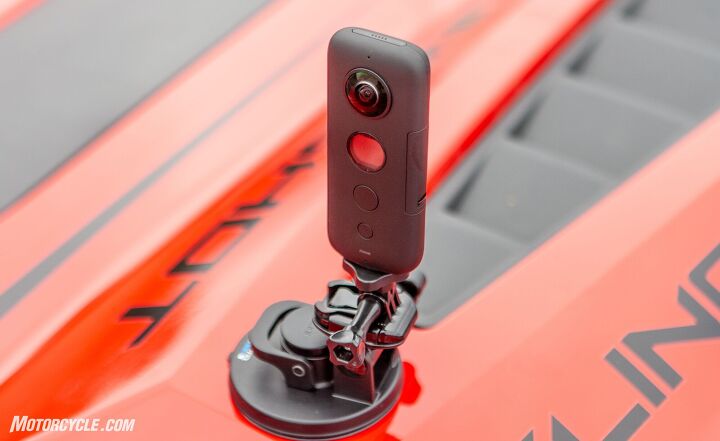













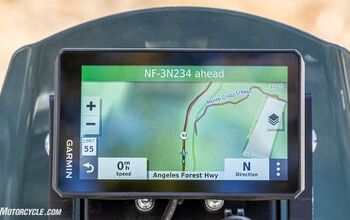
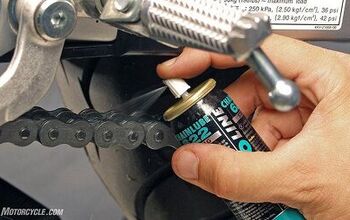
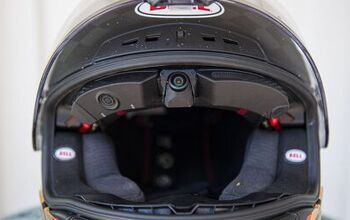

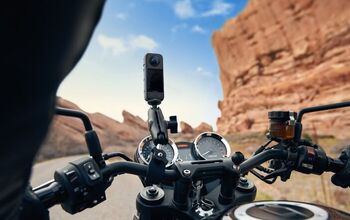

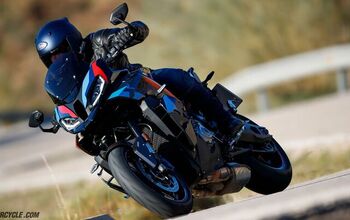










Comments
Join the conversation
I don't even want or need one of these but I watched the whole video anyway. Good job Sean.
I have three different types of cameras. Haven't used any of them in a long time. I kind of lost interest in them.